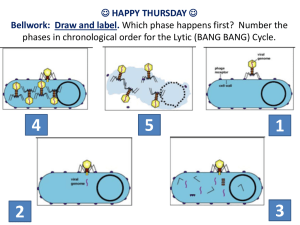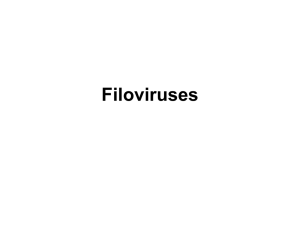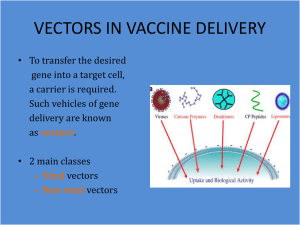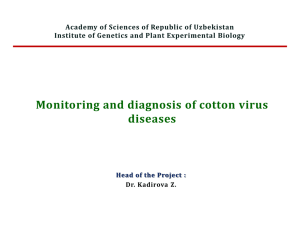Virus
advertisement
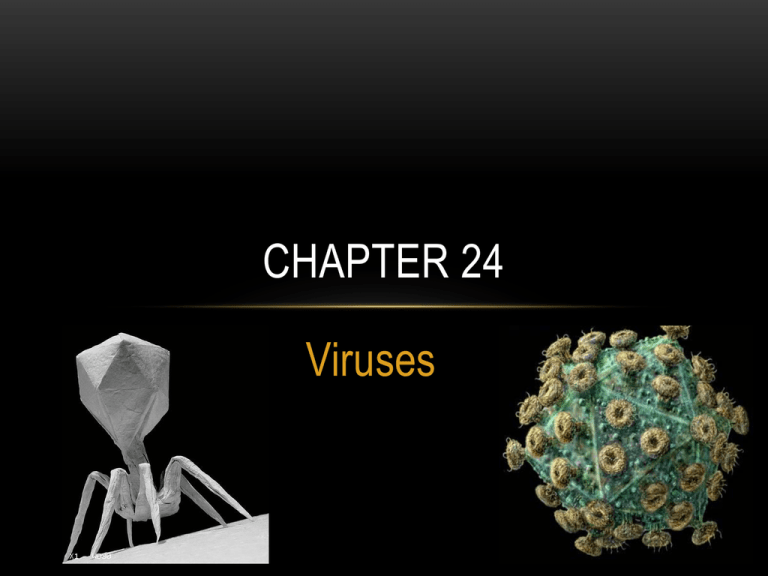
CHAPTER 24 Viruses SECTION 1 VOCABULARY PRETEST • Virus • Capsid • Envelope • Provirus • Retrovirus • Reverse transcriptase • Bacteriophage A. B. C. D. E. Protein coat of a virus Virus that copies DNA from RNA Enzyme used by retroviruses Virus that infects bacteria cells Nonliving particle that replicates inside living cells F. Bilipid membrane surrounding some viruses G. Viral DNA inserted into host DNA • Lytic cycle H. Active viral cycle • Virulent I. • Lysis J. Hidden viral cycle • Lysogenic cycle K. Rupturing of a cell • Temperate virus L. Virus that uses the lytic cycle • Prophage Viral DNA inserted into bacterial chromosome M. Virus that uses the lysogenic cycle ANSWER KEY • Virus E Lytic Cycle H • Capsid A Virulent M • Envelope F Lysis K • Provirus G Lysogenic Cycle J • Retrovirus B Temperate virus L • Reverse transcriptase C Prophage I • Bacteriophage D DISCOVERY OF VIRUSES • Virus: Nonliving particle made up of nucleic acid and a protein coat (or lipid-protein coat) • Cause disease in living organisms • Useful tools for genetic research • Very small (need electron microscope to see) • Can be crystallized CHARACTERISTICS OF VIRUSES • Lack cytoplasm and cellular organelles • Cannot carry out the cellular functions of metabolism, homeostasis, respiration or photosynthesis • Can only reproduce inside a living cell by utilizing the host cell’s ribosomes, ATP, enzymes and proteins. SIZE AND STRUCTURE • Viruses vary in size and shape • Most are surrounded by a protein coat known as a capsid. Capsid shapes include: Helical Polyhedral (Icosahedral) BACTERIOPHAGES • The smallest viruses are those that infect bacteria cells. • They are called bacteriophages. • They have a robot-like shape. ENVELOPED VIRUSES • Some viruses have a bilipid membrane called an envelope that surrounds the capsid. • It forms from the host cell membrane as the virus buds out from the host. • Ex: chickenpox, influenza, and HIV • The proteins on the envelope help the virus recognize host cells. CLASSIFICATION OF VIRUSES • Most viruses are classified according to the type of nucleic acid they contain: DNA or RNA VIRAL REPLICATION • Viruses are obligate intracellular parasites —they replicate only by using host cell enzymes and organelles to make more viruses. REPLICATION IN DNA VIRUSES 1. Virus enters and is uncoated, releasing viral DNA and capsid proteins Virus Capsid proteins 2. Host enzymes replicate the viral genome. Viral DNA mRNA 3. Host enzymes transcribe the viral genome into viral mRNA, which host ribosomes use to make more capsid proteins 4. Viral genomes and capsid proteins self-assemble into new viruses which exit the cell. REPLICATION IN RNA VIRUSES • The genome of RNA viruses serves as a template for the synthesis of mRNA which is then translated to make viral proteins and as a template for making more copies of the viral genome. RETROVIRUSES • Retroviruses are RNA viruses that also contain the enzyme reverse transcriptase • This enzyme uses RNA as a template to make DNA. • The flow of information is backwards (RNA DNA): hence the name “retro” virus. • HIV is a retrovirus. • The viral DNA that is copied by reverse transcriptase is then integrated into the host genome and becomes a provirus. • The provirus remains a permanent resident of the host cell. • The host’s enzymes transcribe the proviral DNA into RNA molecules that function both as mRNA to make viral proteins and as genomes for new viruses. 1. HIV is enveloped and has an RNA core with 2 molecules of reverse transcriptase. Viral RNA DNA 6. Other RNA strands become the RNA genome for the new viruses 7. New viruses assemble and bud out of the cell 2. Virus fuses w/ cell. Capsid proteins are removed. RNA and reverse transcriptase enzymes are Reverse transcriptase released. Provirus 3. Reverse transcriptase synthesizes a dbl. stranded DNA molecule that is incorporated as a provirus 4. Proviral genes are transcribed into viral RNA 5. Some RNA acts as mRNA to get the cell to make viral capsids and other proteins. VIRAL REPLICATION IN PROKARYOTES • Viruses that infect prokaryotes are called bacteriophages, or phages. • Robot-shaped • Replicate using either the lytic cycle or the lysogenic cycle. LYTIC CYCLE • Viruses that use the lytic cycle are called virulent viruses. • Infection results in an immediate replication of up to 200 new phage viruses and the complete destruction (lysis) of the host cell. Lytic Cycle of the T4 phage virus. LYSOGENIC CYCLE • Viruses that use the lysogenic cycle are called temperate viruses. • After infection, these viruses can remain hidden in their host cell for days, months, or years. • The viral genome becomes integrated into the bacteria’s DNA chromosome. It is now called a prophage. • Unlike proviruses, which are permanently integrated, a prophage can exit the host chromosome and then enter the lytic cycle. Lysogenic/Lytic Cycle of the phage Lambda virus VIRUSES: TOOLS FOR BIOTECHNOLOGY • Phage viruses have become very useful in recombinant DNA technology. • Phage DNA is replaced with DNA of interest (ex: human gene for insulin) • Phage is allowed to infect bacteria cells. • Bacteria then produce large amounts of either insulin or copies of the gene for insulin. ORIGIN OF VIRUSES • It is believed that viruses evolved from early cells (since they cannot reproduce without cells) • They were probably tiny pieces of naked nucleic acid that could travel between cells. • Genes for protein coats evolved on a few mutant pieces of DNA and ….the first virus evolved. • Many viruses mutate very quickly (especially RNA viruses). This makes it difficult for the immune system to recognize them as well as to develop vaccines to fight them. SECTION 2 VOCABULARY PRETEST • Vector • Protease inhibitor • Oncogene • Proto-oncogene • Emerging disease • Inactivated virus • Attenuated virus • Viroid • Prion A. B. C. D. E. Infections protein Cancer causing gene Virus that cannot replicate Infectious piece of RNA Weakened virus that cannot cause disease F. Intermediate viral host that transfers a virus G. Drug that blocks the synthesis of new viral capsids H. Illnesses caused by new viruses I. Gene that controls cell replication ANSWER KEY • Vector F • Protease inhibitor G • Oncogene B • Proto-oncogene I • Emerging disease H • Inactivated virus C • Attenuated virus E • Viroid D • Prion A VIRAL DISEASES • Most viruses must be spread by an intermediate host known as a vector. • Vectors can include: humans, animals, mosquitoes, ticks, and fleas. HUMAN VIRAL DISEASES • Chickenpox and Shingles • Caused by the varicella-zoster herpesvirus. • Multiplies in the lungs and travels to blood vessels in the skin causing fever and skin rash • Spread through direct contact with the skin rash and through the air • If the virus stays as a episome in nerve cells, it can later cause shingles Varicella-zoster virus Chickenpox Shingles • Viral Hepatitis • Hepatitis: inflammation of the liver; causing fever, nausea, jaundice and liver failure • Five viruses can cause it: • Hepatitis A and E —spread by fecally contaminated food and water • Hepatitis B, C and D —spread by sexual contact; and blood to blood contact (contaminated needles) Hepatitis C virus • Acquired Immune Deficiency Syndrome (AIDS) • Caused by HIV virus (human immunodeficiency virus) • Destroys immune system • Spread by sexual contact (contact with infected body fluids: blood, semen, vaginal fluid; and from mother to fetus) • RNA retrovirus that can infect T cells of the immune system • It will lyse many of the T cells. Others, it will infect and stay hidden as a provirus to avoid detection. • Efforts to fight AIDS have focused on drugs that interfere with the replication cycle of the virus. • AZT inhibits the ability of reverse transcriptase to make a DNA copy of the viral RNA. • Protease inhibitors block the synthesis of new viral capsids. • Most effective treatments involve a complex combination of several drugs (AIDS cocktail) • With treatment, many people have manage to remain symptom free for many years. VIRUSES AND CANCER • Cancer: results from cells that cannot stop dividing • Some viruses can cause cancer because they contain oncogenes: genes that block the normal controls of cell reproduction. • Other viruses cause cancer because they insert into a host cell’s chromosome near a proto-oncogene which normally controls cell growth. They disrupt the function of this portion of DNA. • Cancers caused by viruses include: Cervical cancer (caused by HPV: human papillomavirus); Liver cancer (caused by Hepatitis B); Leukemia (caused by HTLV: human Tlymphotophic virus); Burkitt’s lymphoma (caused by EpsteinBarr virus) EMERGING VIRAL DISEASES • Emerging Diseases: illnesses caused by new or reappearing infectious agents that typically exist in animal populations— often in isolated habitats—and can infect humans who interact with these animals. • Hemorrhagic fever (Ebola virus) • Fatal pneumonia caused by Hantavirus • SARS Ebola Virus PREVENTION AND TREATMENT • Antibiotics DO NOT work on viruses. Your immune system is your main defense after you have been infected. • Vaccinations: a harmless version of the virus is injected in order to trigger the immune response. These are used to prevent viral infections…not cure them. They make use of: • Inactive viruses: cannot replicate • Attenuated viruses: weakened form that cannot cause disease • Successful vaccines exist for: Measles, mumps, rubella, polio, hepatitis A and B, and chickenpox • Smallpox has been eradicated using a worldwide vaccine campaign carried out by the World Health Organization. • Last known case of smallpox was in 1977 in Somalia • Declared eradicated in 1980 • Vector Control: involves controlling the animal vectors used by viruses. • Ex: Mosquito-control programs help stop the spread of yellow fever: Rabies vaccinations of pets help stop the spread of rabies. • Drug Therapy: this approach is limited to drugs that interfere with viral replication inside cells. • Acyclovir blocks DNA polymerase of herpes viruses and chickenpox virus. They do not destroy the virus. VIROIDS AND PRIONS • Viroids: smallest known particles that can replicate • Short strand of RNA: no capsid • Infect plants: such as coconuts, potatoes and oranges • Prions: infections proteins. • Cause Mad Cow disease, Creutzfeldt-Jakob disease and Kuru

